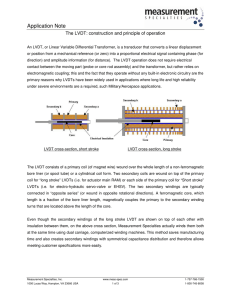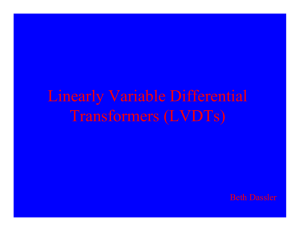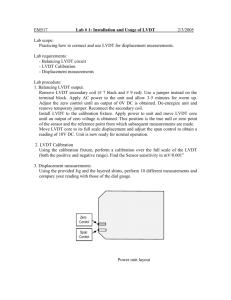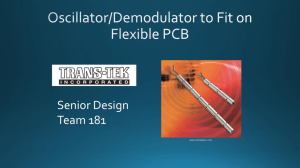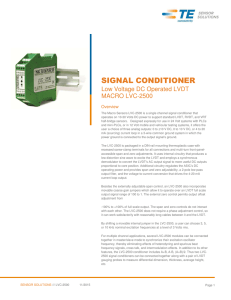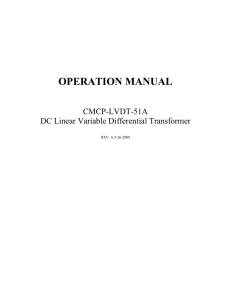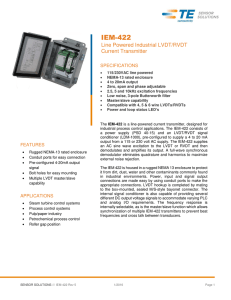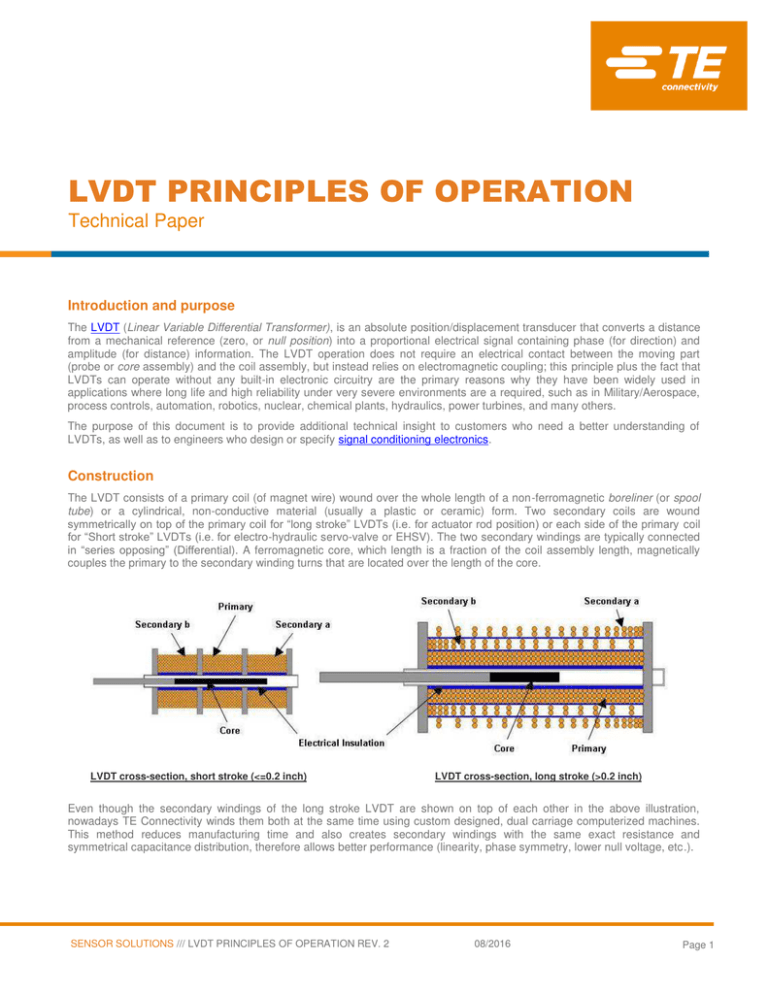
LVDT PRINCIPLES OF OPERATION
Technical Paper
Introduction and purpose
The LVDT (Linear Variable Differential Transformer), is an absolute position/displacement transducer that converts a distance
from a mechanical reference (zero, or null position) into a proportional electrical signal containing phase (for direction) and
amplitude (for distance) information. The LVDT operation does not require an electrical contact between the moving part
(probe or core assembly) and the coil assembly, but instead relies on electromagnetic coupling; this principle plus the fact that
LVDTs can operate without any built-in electronic circuitry are the primary reasons why they have been widely used in
applications where long life and high reliability under very severe environments are a required, such as in Military/Aerospace,
process controls, automation, robotics, nuclear, chemical plants, hydraulics, power turbines, and many others.
The purpose of this document is to provide additional technical insight to customers who need a better understanding of
LVDTs, as well as to engineers who design or specify signal conditioning electronics.
Construction
The LVDT consists of a primary coil (of magnet wire) wound over the whole length of a non-ferromagnetic boreliner (or spool
tube) or a cylindrical, non-conductive material (usually a plastic or ceramic) form. Two secondary coils are wound
symmetrically on top of the primary coil for “long stroke” LVDTs (i.e. for actuator rod position) or each side of the primary coil
for “Short stroke” LVDTs (i.e. for electro-hydraulic servo-valve or EHSV). The two secondary windings are typically connected
in “series opposing” (Differential). A ferromagnetic core, which length is a fraction of the coil assembly length, magnetically
couples the primary to the secondary winding turns that are located over the length of the core.
LVDT cross-section, short stroke (<=0.2 inch)
LVDT cross-section, long stroke (>0.2 inch)
Even though the secondary windings of the long stroke LVDT are shown on top of each other in the above illustration,
nowadays TE Connectivity winds them both at the same time using custom designed, dual carriage computerized machines.
This method reduces manufacturing time and also creates secondary windings with the same exact resistance and
symmetrical capacitance distribution, therefore allows better performance (linearity, phase symmetry, lower null voltage, etc.).
SENSOR SOLUTIONS /// LVDT PRINCIPLES OF OPERATION REV. 2
08/2016
Page 1
THE LVDT: CONSTRUCTION AND PRINCIPLES OF OPERATION
TECHNICAL PAPER
Principles of operation
When the primary coil is excited with a sine wave voltage (Vin), this voltage produces a current in the windings, function of the
input impedance. This variable current generates a variable magnetic flux which, channeled by the high-permeability
ferromagnetic core, induces the secondary sine wave voltages Va and Vb. While the secondary windings are designed so that
the amplitude of the differential output voltage (Va-Vb) is proportional to the core position, the phase of (Va-Vb) with reference
to the excitation, called Phase Shift determines the direction away from the zero position. The zero, called Null Position, is
defined as the core position where the phase shift of the (Va-Vb) differential output is 90 degrees.
LVDT Schematic
The differential output between the two secondary outputs (Va-Vb) when the core is at null position is called the Null Voltage.
As the phase shift is 90 degrees by definition, the null voltage is a “quadrature” voltage. This residual voltage is low; it is due to
the complex nature of the LVDT electrical model, which includes the parasitic capacitances of the windings. This complexity
also explains why the phase shift of (Va-Vb) is not exactly 0 or 180 degrees when the core is away from the null position.
The phase shift is very important as many signal conditioners employ synchronous demodulation to provide a DC output that
is proportional to the following transfer function: RMS voltage (Va-Vb) multiplied by the cosine of phase shift. This is one of
the best ways to provide an accurate and linear (especially around the null) position signal in a measuring system using an
LVDT. It is also the method that allows the minimum numbers of electrical connections to the LVDT, as only 4 are required (2
for the excitation and 2 for the differential output; the secondary windings being connected in series opposing at the LVDT).
One drawback of this technique is that the phase shift has to be low enough to avoid affecting the noise level in the
demodulator, and to prevent a too large signal drop (due to the cosine in the transfer function). To avoid these adverse effects,
TE Connectivity offers electronic instrumentation that includes phase compensation electronic circuitry to bring the phase
shift back to zero.
In some cases it is beneficial to use the secondary sum, (Va+Vb) as the reference for the phase shift of (Va-Vb). However,
one must ensure that the LVDT is designed with windings that provide a fairly constant sum along the stroke to be measured.
The advantage of this method is that the phase shift between the secondary differential and the sum is very low, therefore
there is no need to adjust it. However, only 5 or 6 wire LVDTs must be used. TE Connectivity LVM-110 and LiM-420
LVDT/RVDT signal conditioners operate this way.
LVDT waveforms
SENSOR SOLUTIONS /// LVDT PRINCIPLES OF OPERATION REV. 2
08/2016
Page 2
THE LVDT: CONSTRUCTION AND PRINCIPLES OF OPERATION
TECHNICAL PAPER
Temperature effects and their causes
While the temperature coefficient of sensitivity (sensitivity is the output per unit of displacement) is mostly determined by the
number of winding turns, the resistance of the coils, the geometry of the core, and the resistivity & permeability of the metals
used in the LVDT construction, the null position shift with temperature is mostly affected by the expansion coefficients and
lengths of the materials. The null position is therefore a highly predictable and repeatable reference. As the mounting points in
the application also have their own temperature effects, function of the materials used in the mechanical interface, an LVDT
with a very low null position shift with temperature is generally not desired; a null position temperature shift that matches the
temperature shifts of the mounting points is preferable.
“Ratiometric” operation for low temperature coefficient of output
An LVDT can be designed to maintain a constant sum of the secondary voltages (Va+Vb) over the measuring stroke length.
By using a signal conditioning circuitry that computes the difference over sum ratio R = (Va-Vb) / (Va+Vb), one can see that
the temperature coefficient (TC) could be dramatically reduced (in principle), as confirmed by the following equations:
Secondary output voltages function of temperature: Va(t) = Va(70ºF)*Ca; Vb(t) = Vb(70ºF)*Cb
The variable “t” is the temperature; 70ºF is the reference temperature; Ca and Cb are the temperature coefficients of Va and
Vb respectively. Ca and Cb assumed equal (first order approximation Ca≈Cb≈ C), then the ratio R is independent of
temperature:
[Va(t)-Vb(t)] / [Va(t)+Vb(t)] = [Va(70ºF)*C-Vb(70ºF)*C] / [Va(70ºF)*C+Vb(70ºF)*C]
After simplification: [Va(t)-Vb(t)] / [Va(t)+Vb(t)] ≈ [Va(70ºF)-Vb(70ºF)] / [Va(70ºF)+Vb(70ºF)]
or R(t) ≈ R(70ºF)
In reality the LVDT must be specifically designed for this ratiometric function to achieve the best performance, including the
TC, as several other parameters have to be taken into account.
NORTH AMERICA
EUROPE
ASIA
Measurement Specialties, Inc.,
a TE Connectivity Company
1000 Lucas Way
Hampton, VA 23666
United States
Phone: +1-800-745-8008
Fax: +1-757-766-4297
Email: customercare.hmpt@te.com
MEAS Deutschland GmbH ,
a TE Connectivity Company
Hauert 13
D-44227 Dortmund
Germany
Phone: +49-(0)231-9740-0
Fax: +49-(0)231-9740-20
Email: customercare.dtmd@te.com
Measurement Specialties China Ltd.,
a TE Connectivity Company
No. 26, Langshan Road
High-tech Park (North)
Nanshan District, Shenzhen 518057
China
Phone: +86-755-33305088
Fax: +86-755-33305099
Email: customercare.shzn@te.com
te.com/sensorsolutions
Measurement Specialties, Inc., a TE Connectivity company.
Measurement Specialties, MEAS, American Sensor Technologies, AST, TE Connectivity, TE Connectivity (logo) and EVERY CONNECTION COUNTS are trademarks. All other logos,
products and/or company names referred to herein might be trademarks of their respective owners.
The information given herein, including drawings, illustrations and schematics which are intended for illustration purposes only, is believed to be reliable. However, TE Connectivity makes
no warranties as to its accuracy or completeness and disclaims any liability in connection with its use. TE Connectivity‘s obligations shall only be as set forth in TE Connectivity‘s Standard
Terms and Conditions of Sale for this product and in no case will TE Connectivity be liable for any incidental, indirect or consequential damages arising out of the sale, resale, use or
misuse of the product. Users of TE Connectivity products should make their own evaluation to determine the suitability of each such product for the specific application.
© 2016
TE Connectivity Ltd. family of companies
All Rights Reserved.
SENSOR SOLUTIONS /// LVDT PRINCIPLES OF OPERATION REV. 2
08/2016
Page 3

